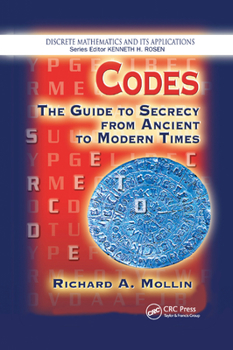Codes: The Guide to Secrecy from Ancient to Modern Times
Select Format
Select Condition 
Book Overview
From the Rosetta Stone to public-key cryptography, the art and science of cryptology has been used to unlock the vivid history of ancient cultures, to turn the tide of warfare, and to thwart potential hackers from attacking computer systems. Codes: The Guide to Secrecy from Ancient to Modern Times explores the depth and breadth of the field, remaining accessible to the uninitiated while retaining enough rigor for the seasoned cryptologist. The book begins by tracing the development of cryptology from that of an arcane practice used, for example, to conceal alchemic recipes, to the modern scientific method that is studied and employed today. The remainder of the book explores the modern aspects and applications of cryptography, covering symmetric- and public-key cryptography, cryptographic protocols, key management, message authentication, e-mail and Internet security, and advanced applications such as wireless security, smart cards, biometrics, and quantum cryptography. The author also includes non-cryptographic security issues and a chapter devoted to information theory and coding. Nearly 200 diagrams, examples, figures, and tables along with abundant references and exercises complement the discussion. Written by leading authority and best-selling author on the subject Richard A. Mollin, Codes: The Guide to Secrecy from Ancient to Modern Times is the essential reference for anyone interested in this exciting and fascinating field, from novice to veteran practitioner.
Format:Paperback
Language:English
ISBN:036739278X
ISBN13:9780367392789
Release Date:September 2019
Publisher:CRC Press
Length:704 Pages
Weight:2.10 lbs.
Dimensions:1.5" x 6.3" x 9.6"
Customer Reviews
1 rating
a historical survey
Published by Thriftbooks.com User , 20 years ago
Mollin has already written several texts on various aspects of cryptography. This book of necessity overlaps with those, to various extents. Here Mollin offers more of a general introduction and guide. Pitched to those outside the field. Whereas his other books are directed to students in cryptography. Hence, this is not a maths book, per se. The historical perspective is nice. Gives you an appreciation of what people did before computers transformed this field. Caesar ciphers, substitutions etc. But in the post WW2 era, high speed electronic computers made a wide impact. Mollin explains how this enabled public key cryptography. Based on the asymmetric effort needed to factor a very large number, compared to generating that number by multiplying a set of primes together. Mollin also looks at the future. Specifically at quantum computing. While early results are intriguing, it is still unclear if this approach will ever prove practical.






